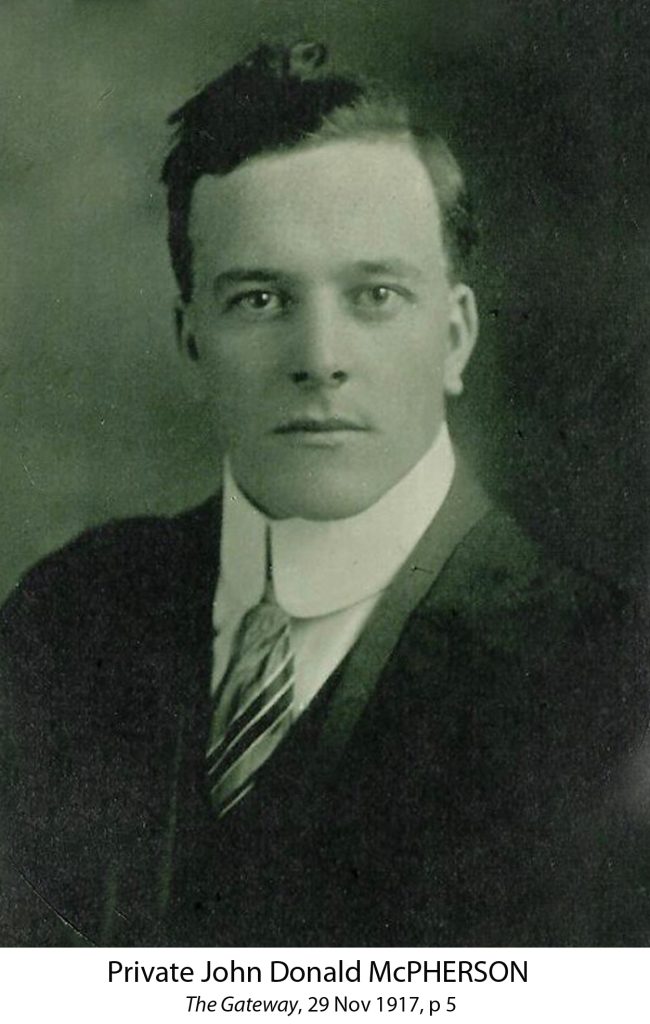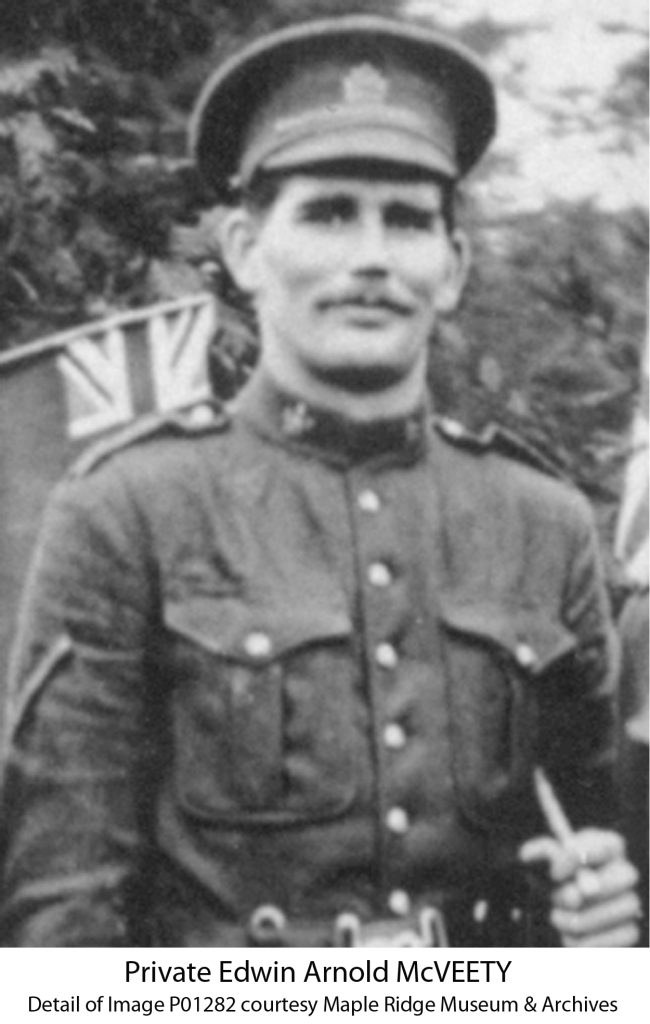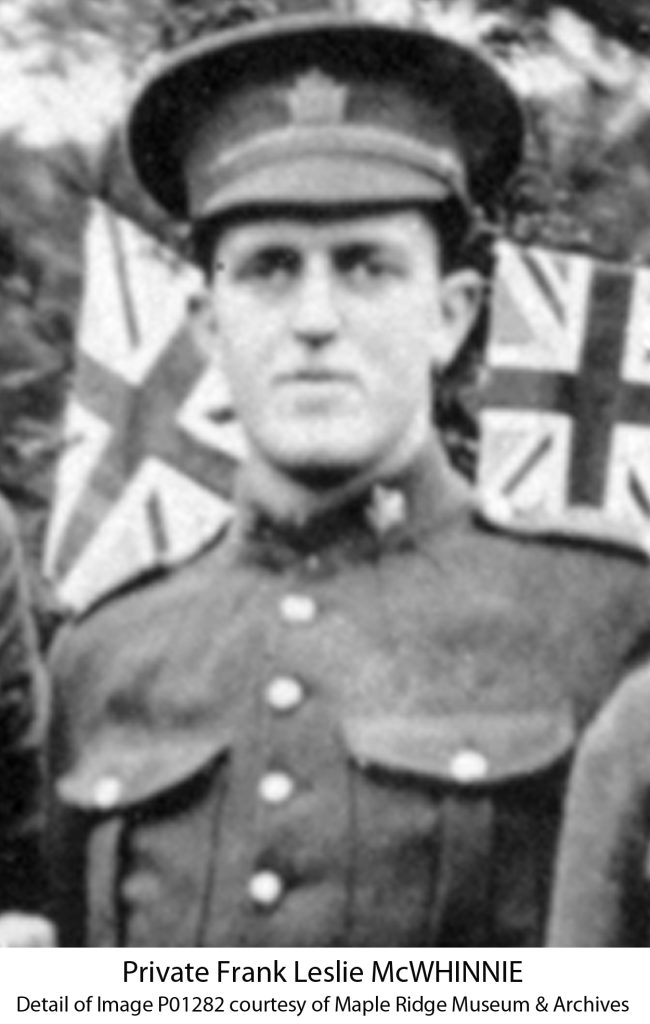Private Wilfred John MACKRETH
Regimental Number: 63326
Enlistment Date / Location / Unit: 30 July 1915 / Vernon, BC / 62nd Battalion
Birth Date / Location: 12 October 1891 / Eynsford, Kent, England (Actual 1890)
Parents: John Mackreth and Annie M. Hampton
Enlistment Date / Location / Unit: 30 July, 1915 / Vernon, BC / 62nd Battalion
Occupation on Enlistment: Farmer
Date of Death / Location: 3 April 1918 / Military Wing of the Royal Columbian Hospital, New Westminster, BC
Age at Death: 27
Unit on Date of Death, or on Demobilization: 62nd Battalion
Circumstances of Death: Died of Injuries Received in Action; Secondary Meningitis
Cemetery or Memorial: Maple Ridge Cemetery, Maple Ridge, BC
Commemorated at: Eynsford Cenotaph, Eynsford, Kent, UK; Maple Ridge Cemetery, Maple Ridge, BC; Maple Ridge Cenotaph, Maple Ridge, BC; First World War Book of Remembrance page 461, Memorial Chamber, Parliament Buildings, Ottawa, ON; Maple Ridge Cenotaph, Maple Ridge, BC; Maple Ridge Legion Branch #88 Memorial Plaque; Municipality of Maple Ridge Honour Roll, St John the Divine Anglican Church, Maple Ridge, BC; The Gold Stripe Roll of Honour, Maple Ridge, page 89; Eynsford Cenotaph, Eynsford, Kent, England
Wilfred John Mackreth was born on 12 October 1890 in Eynsford, Kent, England to William and Annie (Hampton) Mackreth. Annie Hampton was born in Cornwall but her close relative, William Hampton, had immigrated to Port Hammond, BC. Wilfred emigrated from England in 1911, coming to Port Hammond to work on William Hampton’s farm.
Wilfred was in the 104th Westminster Fusiliers of Canada Militia before enlisting. Wilfred enlisted with the Canadian Expeditionary Force on 30 July 1915. He was 1.6 meters (5 feet 4 inches) tall, had blue eyes and black hair. On his left forearm he had a tattoo of clasped hands over a heart; a flag above, and the words “True Love.” At that time, he was deemed medically fit for overseas service. He was part of the 62nd Battalion arriving in Liverpool on 1 December 1915. On 15 May 1916 he was transferred to the 54th Battalion and arrived in Havre, France on 14 August 1916.
On 16 October Wilfred was injured with a gunshot wound to his left shoulder at the Somme. He spent over a month in hospital and then returned to active service. He served in the trenches until his abdomen was severely crushed by a mule wagon on 13 January 1917.
For the remainder of his service, Wilfred was in a series of hospitals in France, England and Canada. This serious injury rendered him unfit for further active service. He was finally invalided to Canada on 17 November 1917, and spent several months in a Vancouver military hospital. Two weeks before his death he was moved to the Military Wing at the Royal Columbian Hospital at New Westminster. His condition continued to both deteriorate and evade treatment, and he became critically ill. He lapsed into a coma and died 3 April 1918.
He was buried with a military funeral under the auspices of the Military Hospitals Commission. Pall bearers were returned soldier patients from Shaughnessy Military Hospital and included a firing party from the Railway Service Guard. He is buried in the Maple Ridge Cemetery.
Wilfred Mackreth’s name was inscribed on the Cenotaph when it was unveiled in 1923 as W. Mackreath.
(Updated 19-Feb-2024)

Private James Andrew MacKENZIE
Regimental Number: 703735
Enlistment Date / Location / Unit: 24 February 1916 / Vancouver, BC / 102nd Battalion
Birth Date / Location: 24 January 1901 / Ayr, Scotland (1899 on attestation)
Parents: William Ferguson MacKenzie and Elizabeth Watson Mason
Occupation on Enlistment: Baker
Date of Death / Location: 18 July 1918 / Alice Arm, British Columbia
Age at Death: 17
Unit on Date of Death, or on Demobilization: 102nd (Comox-Atlin) Battalion
Where & when demobilized: Discharged 12 November 1917 because he was underage
Circumstances of Death: Crushed by falling rock from a blast at the Alice arm mine
Cemetery or Memorial: Mountain View Cemetery, Vancouver, BC
Where commemorated: Maple Ridge Cenotaph, Maple Ridge, BC
James Andrew MacKenzie (sometimes McKenzie) was born 24 January 1901 in Ayrs, Scotland to William Ferguson Mackenzie and Elizabeth Mason. James, his mother and brother John sailed to Canada on the SS Pretorian in 1907 to join William.
William owned a bakery on Davie Street in Vancouver and also owned property in Township 12 (Webster’s Corner). James McKenzie’s name appears in the Municipality of Maple Ridge tax rolls for 1915 through to 1918 as owning property in Township 12 care of Vancouver real estate firm Hood Brothers but as to whether it is the same James MacKenzie is unknown.
James was 15 years old, 1.7 meters (5 feet 7 3/4 inch) tall, 63.5 kilograms (140 pounds), with a dark complexion, dark brown hair, and grey eyes when he enlisted with the 102nd (Comox-Atlin) Battalion, in Vancouver 24 February 1916.
He listed his present address as Davie Street, Vancouver, and his occupation as a baker on his attestation.
His unit left for England 18 June 1916 and embarked for France in August. James was discharged on 12 November 1917 for being underage though his conduct was reported as “very good” and returned to Canada on the SS Megantic on 14 August 1917. He went up north to work as a miner in Anyox and killed by falling rock from a blast in an explosion on 18 July 1918.
He was interred in the Returned Soldier’s plot at Mountain View cemetery. The 24 July 1918 Vancouver Province reported that “one of the finest wreaths ever designed in Vancouver” was prepared by James’ returned soldier comrades for the funeral.
James’ parents moved to Albion in 1922. William became a poultry farmer. He was a member of the St. David Masonic Lodge at Haney and served on the Maple Ridge Council in 1929 and 1930.
J. McKenzie was added to the Cenotaph in 2000.
(Updated 24-Oct-2024)

Private John Donald McPHERSON
Regimental Number: 911412
Enlistment Date / Location / Unit: 11 April 1916 / Edmonton, AB / 196th Battalion
Birth Date / Location: 23 June 1897 / Spruce Grove, AB
Parents: John Allan McPherson and Christine Hodel. Stepmother Eva Mabel Watson
Occupation on Enlistment: Farmer
Date of Death / Location: 26 October 1917 / Passchendaele, Belgium
Age at Death: 20
Unit on Date of Death, or on Demobilization: 46th Battalion
Circumstances of Death: Killed in Action, Passchendaele
Cemetery or Memorial: Menin Gate Memorial, Ypres, Belgium, Panel 28
Medals/Awards: British War Medal, Victory Medal
Commemorated at: First World War Book of Remembrance, page 351, Memorial Chamber, Parliament Buildings, Ottawa, ON; Maple Ridge Cenotaph, Maple Ridge, BC; Menin Gate Memorial, Ypres, Belgium; Spruce Grove Pioneer Cemetery, Spruce Grove, AB; War Memorial Plaque, Arts and Convocation Hall, University of Alberta, Edmonton, AB
John Donald McPherson was born in Spruce Grove, AB on 23 June 1897. In 1915 John was part of a small group of 12 students enrolled in the College of Agriculture at the University of Alberta in Edmonton. He enlisted along with many of his peers on 10 April 1916 with the University of Alberta Company of the 196th Battalion. He was 1.6 meters (5 feet 6 inches) tall, weighed 74 kilograms (163 pounds), had grey eyes and black hair.
While originally with the 196th Battalion, he was transferred to the 46th Battalion. This later came to be known as the “Suicide Battalion” owing to the casualty rate of almost 92 percent.
John arrived in England 11 November 1916. He was given training with the Lewis gun in August 1917, and was in charge of a Lewis gun team of seven at the Battle of Passchendaele in Belgium. The First Gunner carried the gun and a revolver, the Second Gunner carried a bag containing spare parts, and the remaining five members of the team carried loaded pans of ammunition. John was hit in the head and killed by a piece of shrapnel from an enemy shell during the advance at Passchendaele.
His name is listed on the Menin Gate (Ypres) Memorial, honouring those soldiers whose bodies were never recovered. Dean Howes of the University of Alberta wrote in the 29 November 1917 issue of The Gateway that he remembered “John as a lad of quiet manner and kindly disposition.”
John’s younger brother, George Allan McPherson, Regimental No. 911355, also enlisted and served overseas. While George was both wounded and gassed, he was able to return home to Alberta.
John’s father, John Allan McPherson, was formerly an MLA in Alberta and then the Sheriff of Red Deer. The McPhersons moved to Port Hammond in 1921, and contributed greatly to the community. They donated land for a Presbyterian church on 207 Street in Maple Ridge.
J McPherson’s name was added to the Cenotaph in 2000 as part of the Legion’s Millennium project.
(Updated 03-Jan-2024)

Private Edwin Arnold McVEETY
Regimental Number: 75509
Enlistment Date / Location / Unit: 11 November 1914 / Vancouver, BC / 29th Battalion
Birth Date / Location: 26 September 1886 (actual 1885) / North Dakota, USA
Parents: William John McVeety and Mary Currie
Occupation on Enlistment: Rancher
Date of Death / Location: 6 April 1916 / St. Eloi, Belgium
Age at Death: 31
Unit on Date of death, or on Demobilization: 29th Battalion
Circumstances of Death: Killed in action
Cemetery: Menin Gate Memorial, Ypres, Belgium, Panel 28
Medals/Awards: 1914-15 Star, British War Medal, Victory Medal
Where commemorated: Canadian Virtual War Memorial, Veterans Affairs Canada; First World War Book of Remembrance page 131, Memorial Chamber, Parliament Buildings, Ottawa, ON; Maple Ridge Cenotaph, Maple Ridge, BC; Maple Ridge Legion Branch #88 Memorial Plaque; Menin Gate Memorial, Ypres, Belgium; Municipality of Maple Ridge Honour Roll, St John the Divine Anglican Church, Maple Ridge, BC; The Gold Stripe Roll of Honour, Maple Ridge, page 89
Edwin Arnold McVeety, known as “Arnold”, was born in North Dakota on 26 September 1885. The family moved to Swan River, MB in 1900, followed by Port Haney, BC early in 1911. The McVeety family were long time residents of Maple Ridge and the immediate family are all buried at Maple Ridge Cemetery.
Arnold was 104th Westminster Fusiliers of Canada militia prior to enlisting with Canadian Expeditionary Force. Arnold was one of three brothers; his older brother Ernest Willmour also served in the First World War. Arnold, a 1.8 meter (six-foot-tall) rancher, weighed 84 kilograms (185 pounds), had grayish blue eyes and dark brown hair. He enlisted on 11 November 1914 with the 29th Battalion. His brother, Willmour, a Bridge Carpenter, enlisted earlier on 21 September (Regimental No. 502050) and was placed with the Canadian Overseas Railway Construction Corps. Willmour survived the war.
On 20 May 1915, Arnold sailed to England and embarked for France on the R.M.S. Misambic on 17 September 1915. From 14 to 19 February 1916 he attended Trench Warfare School.
The Battle of St. Eloi Craters was fought from 27 March to 16 April 1916. It was a horrific battle fought from inside the many bombed, water-filled craters, with the soldiers crouching in mud or standing in waist-deep water, unable to sit. It was during this battle that Arnold was given a pass to take leave, effective the next day. Surprisingly, he asked that it be deferred until the following week when his friend could join him. Arnold wrote to his mother on the 4th of April, and told her that he turned down his pass, and had to admit that was a very foolish move. Two days later, Arnold was in a group reinforcing the garrison in the craters, and was killed instantly by shell fire. His body was never recovered.
Ironically, Arnold was promoted to (Lance) Corporal on 11 April; he had not yet been declared dead during the confusion and difficult conditions of the battle. While the promotion was rescinded, some records still show him as a Lance Corporal.
E.A. McVeety’s name was on the Cenotaph when it was unveiled in 1923.
(Updated 03-Jan-2024)

Private Frank Leslie McWHINNIE
Regimental Number: 75995
Enlistment Date / Location / Unit: 13 November 1914 / Vancouver, BC / 29th Battalion
Birth Date / Location: 20 June 1894 / Ladner’s Landing, BC
Parents: Arthur Alexander McWhinnie and Annie Henry
Occupation on Enlistment: Ranching
Date of Death / Location: 12 Dec 1918 / Metz Hospital, France
Age at Death: 20
Unit on Date of Death, or on Demobilization: 29th Battalion Canadian Infantry
Circumstances of Death: Died Of Influenza in French Hospital Metz 1 month after his release as a Prisoner of War on Armistice Day.
Cemetery or Memorial: Chambieres French National Cemetery Metz, Moselle, France. grave 400
Medals / Awards: 1914-15 Star, British War Medal, Victory Medal
Where commemorated: Canadian Virtual War Memorial, Veterans Affairs Canada; First World War Book of Remembrance page 465, Memorial Chamber, Parliament Buildings, Ottawa, ON; Maple Ridge Cenotaph, Maple Ridge, BC; Maple Ridge Legion Branch #88 Memorial Plaque; Municipality of Maple Ridge Honour Roll, St John the Divine Anglican Church, Maple Ridge, BC; The Gold Stripe Roll of Honour, Maple Ridge, page 89
Frank Leslie McWhinnie was born 20 June 1894, the third child of Arthur Alexander McWhinnie and Annie (nee Henry) McWhinnie. Their eldest child Lillie was born in Vancouver where Arthur worked with his brothers. They next moved to Ladner before settling in Port Haney in 1903 where their youngest son Thomas was born. After Arthur’s death in 1908, Annie managed the farm with the help of Frank and her youngest children. On 10 November 1914, Annie married Joseph Alfred Beeton in Mission, BC.
Frank was one of the first Maple Ridge men to enlist, along with Reginald Goffin, Edwin McVeety, and Edwin Kendrick. When Frank joined the 104th Regiment, he was following the military tradition of his American grandfather, Union Corporal John Henry. On 13 November 1914, Frank signed his attestation papers in Vancouver. He was 20 years and 6 months old with blue eyes and black hair, standing 1.8 meters (5 feet 10 inches) tall, weighing 75 kilograms (165 pounds) with a chest girth of 38 ½ inches. Four of Frank’s sisters married men who were enlisted in the Canadian Expeditionary Force. His older sister, Annie and her husband, Sapper William J Hynds became fruit and poultry farmers in Haney.
On 20 May 1915 Frank sailed with the 29th Canadian Infantry Battalion from Montreal aboard the SS Missanabie, disembarking at Boulogne, France on 18 September 1915. He was officially declared missing on 19 April 1916 after the Battle of St Eloi. On 6 July 1916 he was declared a Prisoner of War at Giessen, Metz, Germany.
On Armistice Day, Frank was officially released from Geissen. But he remained in the nearby French Hospital Metz, until his death from influenza on 12 December 1918.
Frank’s mother received the medals Frank earned as well as the Silver Cross. He is buried in the Chambieres French National Cemetery Metz, Moselle, France. Frank’s youngest sister, Florence, became a nurse in 1922 when she was 18 years old. His youngest sibling, Thomas named his first son, Frank Leslie McWhinnie (1931-2001), in honour of his brother.
F. McWhinnie’s name was inscribed on the Cenotaph when it was unveiled in 1923.
(Updated 11-Feb-2024)

